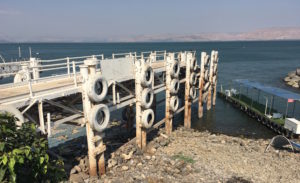
By Marney Blom
The Sea of Galilee is disappearing! In disbelief, I stood beside my Israeli friends and pointed to the abandoned boat dock more than six meters (20 feet) above the Sea of Galilee’s water line. Whitewashed tires, once serving as boat bumpers, were now suspended high above the exposed rusty metal pillars embedded into the rocky dry ground – formerly the bottom of the sea.
It was September 2018 and the water level had plummeted precariously low — the result of a five-year drought coupled with increased domestic and commercial consumption by Israel, Lebanon, and Jordon. The water line had, in fact, reached its lowest level in at least 98 years since scientists first started recording measurements in 1920. Any lower, it would put the Sea of Galilee at risk of becoming irreversibly salinzed. The salt water springs under the lake are held in check only by the pressure of the Sea’s freshwater on top.
Then it started to rain. And rain. And rain. Until northern Israel surpassed its average yearly precipitation by 130 percent with even more rain on the way. Added to that were the large quantities of melting snow on Mount Hermon, also expected to flow into the Kinneret — the name Israelis call the Sea of Galilee. In total, water levels could rise to more than three meters (10 feet).
The Sea on which Jesus famously walked may be witnessing another miracle!
Believers in Israel welcome the abundance of rain as a sign of God’s blessings. They point to scriptures that foretell a day of spiritual refreshing when the God of Israel will pour out His Spirit on the House of Israel (Ezekiel 39:29), and with it, they believe, a great harvest will come.
You sent abundant rain, O God,
to refresh the weary land.
There your people finally settled,
and with a bountiful harvest …
(Psalm 68:9,10)
Marney Blom is news director for the Acts News Network.
Copyright 2019 © Acts News Network, Inc.
